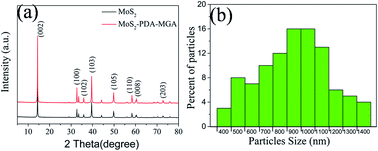Investigating the tribological behavior of PEGylated MoS2 nanocomposites as additives in polyalkylene glycol at elevated temperature
Abstract
MoS2–polydopamine–methoxypolyethyleneglycol amine (MoS2–PDA–MGA) was synthesized through the combination of mussel-inspired chemistry and the Michael addition reaction. The modification of MoS2 via PDA and MGA enhanced its dispersion stability in oil. The tribological properties of MoS2–PDA–MGA for use as additives in polyalkylene glycol (PAG) base oil were investigated using an oscillating reciprocating tribometer at elevated temperatures. The results indicated that the addition of 0.7 wt% MoS2–PDA–MGA in PAG resulted in excellent friction-reducing and anti-wear (AW) performances compared with PAG base oil. The tribological results of MoS2–PDA–MGA and MoS2 dispersed in PAG base oil after settling for 7 days indicate that MoS2–PDA–MGA, with its good dispersion stability, has stable friction-reducing and AW properties. XPS analysis suggested that a protective boundary film formed on the wear surfaces during the friction and wearing process, which was believed to be responsible for the excellent tribological performance of MoS2–PDA–MGA dispersed in PAG at elevated temperature.



 Please wait while we load your content...
Please wait while we load your content...